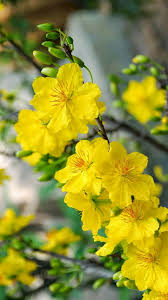Mai flowers, with their vibrant blooms and cultural significance, play a central role in traditional festivals across many cultures. These festivals serve as important occasions for communities to come together, celebrate shared heritage, and foster a sense of unity and belonging. Here, we explore the connection between Mai flowers and the spirit of community in traditional festivals.

1. Symbol of Unity and Togetherness:
In traditional festivals, Mai flowers symbolize unity and togetherness among community members. The act of decorating communal spaces, homes, and altars with Mai flowers brings people together in a collective effort to beautify and honor their shared traditions. Whether it’s hanging garlands of Mai flowers in village squares or adorning temples with elaborate floral arrangements, the presence of Mai flowers reinforces bonds of camaraderie and solidarity within the community.
2. Cultivation of Cultural Identity:
Mai flowers are deeply ingrained in the cultural identity of many communities, serving as symbols of prosperity, good fortune, and new beginnings. During traditional festivals, the display of Mai flowers reaffirms cultural values and customs, preserving and transmitting them to future generations. Through rituals, performances, and ceremonies associated with Mai flowers, communities reaffirm their cultural heritage and strengthen their collective identity.
3. Expression of Gratitude and Reverence:
In traditional festivals, Mai flowers are often offered as tokens of gratitude and reverence to ancestors, deities, and spirits. Through rituals and ceremonies, community members express their appreciation for blessings received and seek guidance and protection for the future. The act of presenting Mai flowers in sacred spaces underscores a deep-seated reverence for nature and the divine, fostering a sense of humility and interconnectedness within the community.
4. Celebration of Seasonal Cycles:
Many traditional festivals coincide with seasonal cycles, marking important transitions in the natural world. Mai flowers, with their vibrant blooms, are often associated with the arrival of spring and the renewal of life. By incorporating Mai flowers into festival decorations and rituals, communities celebrate the changing seasons and the abundance of nature, instilling a sense of awe and wonder for the cycles of life and the interconnectedness of all living beings.
5. Promotion of Social Cohesion:
Participation in traditional festivals involving Mai flowers fosters social cohesion and mutual support within communities. From organizing parades and performances to preparing communal feasts and offerings, community members collaborate and bond over shared responsibilities and activities. These festive occasions provide opportunities for people to forge new friendships, strengthen existing bonds, and cultivate a sense of belonging that transcends individual differences.
Conclusion:
In conclusion, Mai flowers play a significant role in fostering community spirit and cultural cohesion during traditional festivals. Through their symbolism, rituals, and communal activities, Mai flowers unite communities, cultivate cultural identity, express gratitude and reverence, celebrate seasonal cycles, and promote social cohesion. As integral components of traditional festivals, Mai flowers embody the spirit of community and the enduring values of unity, diversity, and collective celebration.
Fostering Community Bonds and Social Harmony:
In addition to their symbolic significance, Mai flowers contribute to the cultivation of strong community bonds and social harmony during traditional festivals.
1. Encouraging Participation and Inclusivity:
The presence of Mai flowers in traditional festivals encourages widespread participation and inclusivity within the community. Regardless of age, gender, or social status, community members are invited to join in the festivities, contribute their talents, and partake in the rituals associated with Mai flowers. This sense of inclusivity fosters a spirit of unity and belonging, where everyone feels valued and respected for their contributions.
2. Strengthening Interpersonal Relationships:
Traditional festivals featuring Mai flowers provide opportunities for community members to strengthen interpersonal relationships and forge new connections. Whether through collaborative efforts in preparing festival decorations or engaging in communal activities such as dancing, singing, or storytelling, individuals come together to share experiences, exchange ideas, and build meaningful bonds that transcend individual differences.
3. Promoting Cultural Exchange and Understanding:
Mai flowers serve as catalysts for cultural exchange and understanding during traditional festivals, where diverse communities come together to celebrate shared traditions and values. Through the exchange of customs, rituals, and folklore associated with Mai flowers, people gain insights into each other’s cultural heritage, fostering mutual respect, appreciation, and a sense of unity amidst diversity.
4. Nurturing Generational Bonds:
Participation in traditional festivals featuring Mai flowers strengthens generational bonds within the community, as elders pass down knowledge, skills, and stories to younger generations. Through hands-on involvement in festival preparations and rituals, younger members learn about their cultural heritage and develop a sense of pride and belonging in their community. This intergenerational exchange of wisdom and traditions ensures the continuity and vitality of cultural practices surrounding Mai flowers.
5. Building Resilience and Collective Spirit:
Traditional festivals featuring Mai flowers instill a sense of resilience and collective spirit within communities, as they come together to overcome challenges and celebrate their shared identity. In times of adversity or hardship, the collective rituals and celebrations centered around Mai flowers provide a source of strength, inspiration, and hope, uniting people in their resolve to persevere and thrive despite obstacles.
Conclusion:
In conclusion, Mai flowers play a pivotal role in nurturing community bonds and social harmony during traditional festivals. Through their ability to encourage participation and inclusivity, strengthen interpersonal relationships, promote cultural exchange and understanding, nurture generational bonds, and build resilience and collective spirit, Mai flowers embody the essence of community and collective celebration. As integral components of traditional festivals, Mai flowers serve as powerful symbols of unity, diversity, and the enduring spirit of humanity.









